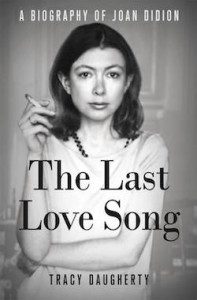
There is something slightly uncomfortable about every book that forces life into narrative—narrative elides; narrative obscures. But it is more than slightly uncomfortable when the life being crammed into narrative’s arc is the life of a woman who has spent many years telling us to distrust that very thing.
This is the thought that kept recurring in my mind while reading The Last Love Song, Tracy Daugherty’s account of the life of Joan Didion thus far. It crafts a smooth, scenic arc that follows Didion’s well-known life story, from her early years in California through her later years in New York. It recounts her childhood—she made her grandmother cry; she flipped through Vogue with her cousin—and the several years she spent at that very magazine. We see her marry John Gregory Dunne, return to California, and adopt a baby girl she names Quintana Roo. Next come a move to Brentwood and a retreat to New York once Dunne gets “the jits.” Back to New York, the death of Dunne, the death of Quintana, the publication of two very good books. And though such a seamless approach may fly in the face of Didion’s philosophies—we tell ourselves stories in order to live, you’ll recall—Daugherty does a fine job of stitching together a writer’s life for the pleasure of the reading masses.
Whether or not Daugherty sins against the spirit of his subject’s work, his book is thorough. Well, as thorough as any biography can be without the subjects’ diaries or cooperation. (Didion apparently did not keep detailed diaries of her daily life or take up Daugherty’s offers to be interviewed.) Daugherty has done a number of interviews, though some are less informative than others, and a good deal of research, though one sometimes wishes he focused less on Dunne, Dunne’s brother Dominick, and general twentieth-century American history. A majority of the material that is specifically on Didion seems to be recycled from her published works. If you have read Slouching Toward Bethlehem, Year of Magical Thinking or The White Album, Daugherty’s book will feel a little like listening to a great Beatles cover band. It’s satisfying to hear the songs you love, but it’s not the same as the real thing.
Take, for example, Daugherty’s rendering of the first time Didion went to New York:
Didion’s first glimpse of Manhattan, from an Idlewild bus into town, was obscured by spring rain…. It didn’t rain in Sacramento in the late spring or summer. Her dress was too thin. She’d known it the instant she’d stepped off the DC-7 in Idlewild’s makeshift terminal and sensed the moisture in the air—warm air tinged with mildew.
A good scene, but it falls flat when compared to Didion’s original:
When I first saw New York I was twenty, and it was summertime, and I got off a DC-7 at the old Idlewild temporary terminal in a new dress which had seemed very smart in Sacramento but seemed less smart already, even in the old Idlewild temporary terminal, and the warm air smelled of mildew and some instinct, programmed by all the movies I had ever seen and all the songs I had ever heard sung and all the stories I had ever read about New York, informed me that it would never be quite the same again. In fact it never was.
Typically, one cannot (wholly) blame a biographer for not producing work that pleases in the same way his subject’s does. Biography is not so much an aesthetic practice as an analytical one. It seeks to understand a person, as much as this can be done, and help others do the same. However, Daugherty tries so hard to mimic his subject’s style—he, for example, repeats key phrases (often italicized) as Didion does in works such as Year of Magical Thinking—that it’s difficult not to draw a comparison between the two writers. And the comparison does not favor the biographer.
According to Hermione Lee—the biographer of writers such as Virginia Woolf, Willa Cather, and, most recently, Penelope Fitzgerald—“Writing a biography is not a love affair. It’s not a marriage. It’s a job, it’s a piece of work.” This is advice that Daugherty didn’t seem to take, because when he’s not showing his affection for his subject through his aspirational style, he’s fondly referring to Didion as things like “the famously frail bird in a sweater.”





